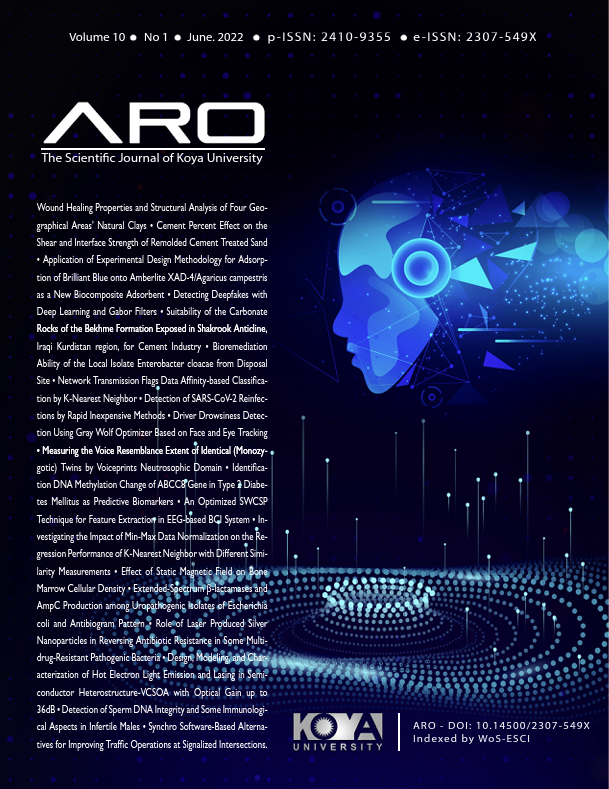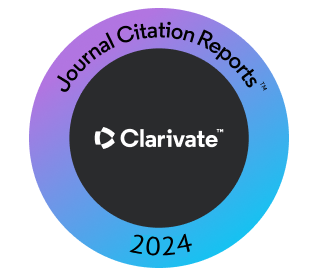Measuring the Voice Resemblance Extent of Identical (Monozygotic) Twins Using Voiceprints Neutrosophic Domain
DOI:
https://doi.org/10.14500/aro.10925Keywords:
Identical Twins, Monozygotic, Neutrosophic domain, VoiceprintAbstract
The identical twins (Monozygotic) are siblings created from the division of one fertilized egg (zygote), so they will be identical in their genetic characteristics and therefore in their phenotypic traits to a very large extent. Among these traits is the voice or the voiceprint of these twins. This research aims to suggest a method to determine the extent of the similarity and the difference between the voiceprints between the brothers of the identical twins and thus, it is possible to distinguish between their voices. This study relied on using a number of audio clips collected from 35 identical twins. The proposed method is based on the use of the spectrogram that represents the voiceprint of the twins. The spectrogram is a two-dimensional function that can be used in the Neutrosophic Transformation to convert the voiceprints to the Neutrosophic domain represented by three membership functions (True, False, and Indeterminate). The results showed that the average extent of the similarity ratio between twins’ voices (True membership) is 67.6%, the difference ratio (False membership) is 32.3%, and the indeterminacy membership function ratio is 18.2%.
Downloads
References
Ali, M.L., Son, H., Khan, M. and Tung, N.T., 2018. Segmentation of dental X-ray images in medical imaging using neutrosophic orthogonal matrices. Expert Systems With Applications, 91, pp.434-441.
Ariyaeeinia, A., Morrison, C., Malegaonkar, A. and Black, S., 2008. Atest of the effectiveness of speaker verification for differentiating between identical twins. Science and Justice, 48, pp.182-186.
Broumi, S., Nagarajan, D., Bakali, A. and Talea, M., 2019. Implementation of neutrosophic function memberships using MATLAB program. Neutrosophic Sets and Systems, 27(1), pp.44-52.
Cavalcanti, J.C., Eriksson, A. and Barbosa, P.A., 2021. Multiparametric analysis of speaking fundamental frequency in genetically related speakers using different speech materials: Some forensic implications, Journal of Voice, In Press.
Cielo, A.C., Agustini, R. and Finger, L.S., 2012. Vocal Characteristics of Monozygotic Twins. Revista CEFAC, pp.1234-1243.
Fuchs, M., Oeken, J., Hotopp, T., Täschner, R., Hentschel, B. and Behrendt, W., 2000. Similarity of monozygotic twins regarding vocal performance and acoustic markers and possible clinical significance. HNO, 48(6), p.462.
Khaleel, Y.A., 2020. High security and capacity of image steganography for hiding human speech based on spatial and cepstral domains. ARO-The Scientific Journal of Koya University, 8(1), pp.95-106.
Kodate, K., Inaba, R., Watanabe, E. and Kamiya, T., 2002. Facial recognition by a compact parallel optical correlator. Measurement Science and Technology, 13, pp.1756-1766.
Kong, A.W.K., Zhang, D. and Lu, G., 2006. Astudy of identical twins’ palmprints for personal verification. Pattern Recognition, 39, pp.2149-2156.
Künzel, H.J., 2011. Automatic speaker recognition of identical twins. The International Journal of Speech, Language and the Law, 17(2), pp.251-277.
Li, J., Zhang, L., Guo, D., Zhuo, S. and Sim,T., 2015. Audio-visual twins database. International Conference on Biometrics, 2015, pp.493-500.
Sataloff, R.T., Herman-Ackah, Y.D. and Hawkshaw, M.J., 2007. Clinical Anatomy and physiology of the voice. Otolaryngologic Clinics of North America, 40(5), pp.909-929.
Sebastian, S., Benadict, A.S., Sunny, G.K. and Balraj, A., 2013. An investigation into the voice of identical twins. Otolaryngology Online Journal, 3(2), pp.1-7.
Segundo, E.S., Tsanas, A. and Vilda, P.G., 2017. Euclidean Distances as measures of speaker similarity including identical twin pairs: A forensic investigation using source and filter voice characteristics. Forensic Science International, 270, pp.25-38.
Smarandache, F., 2001. An introduction to neutrosophy, neutrosophic logic, neutrosophic set, and neutrosophic probability and statistics. 1st International Conference on Neutrosophy, Neutrosophic Logic, Neutrosophic Set, Neutrosophic Probability and Statistics, University of New Mexico-Gallup 1-3December, pp.1-17.
Van Gysel, W.D., Vercammen, J. and Debruyne, F., 2001. Voice similarity in identical twins. Acta Otorhinolaryngologica Belg, 55(1), pp.49-55.
Whiteside, S.P. and Rixon, E., 2000. The identification of twins from pure (single speaker) syllables and hybrid (fused) syllables: An acoustic and perceptual case study. Perceptual and Motor Skills, 91, pp.933-947
Downloads
Published
How to Cite
Issue
Section
License
Authors who choose to publish their work with Aro agree to the following terms:
-
Authors retain the copyright to their work and grant the journal the right of first publication. The work is simultaneously licensed under a Creative Commons Attribution License [CC BY-NC-SA 4.0]. This license allows others to share the work with an acknowledgement of the work's authorship and initial publication in this journal.
-
Authors have the freedom to enter into separate agreements for the non-exclusive distribution of the journal's published version of the work. This includes options such as posting it to an institutional repository or publishing it in a book, as long as proper acknowledgement is given to its initial publication in this journal.
-
Authors are encouraged to share and post their work online, including in institutional repositories or on their personal websites, both prior to and during the submission process. This practice can lead to productive exchanges and increase the visibility and citation of the published work.
By agreeing to these terms, authors acknowledge the importance of open access and the benefits it brings to the scholarly community.
Accepted 2022-05-14
Published 2022-05-27
















 ARO Journal is a scientific, peer-reviewed, periodical, and diamond OAJ that has no APC or ASC.
ARO Journal is a scientific, peer-reviewed, periodical, and diamond OAJ that has no APC or ASC.